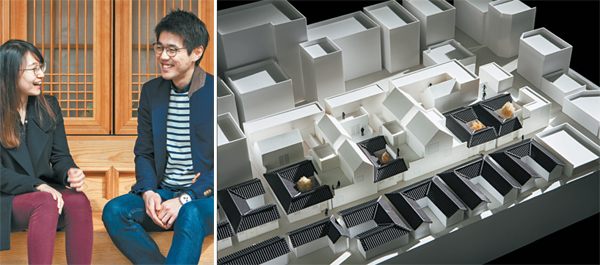Reimagining hanok as communal buildings

Left: Jung Eun-ju and Lee Hee-won won first place in this year’s Heritage Tomorrow Project competition, run by Arumjigi Culture Keepers. Right: “Bang Bang Got Got,” the duo’s design that won the competition. By Park Wan-soon
Budding architects Lee Hee-won, 30, and Jung Eun-ju, 28, gave this question a lot of thought last winter.
The two have worked together on various projects while studying at the University of Seoul and have since then decided to live in a house they would one day build together.
The compatible couple has agreed on most things and has recently won the Heritage Tomorrow Project contest put on by the nonprofit culture body Arumjigi Culture Keepers Foundation.
The pair succeeded in designing a hanok, or a traditional Korean home, reimagined to fit in with the 21st-century cityscape of Seoul. Their project “Bang Bang Got Got” - a play on words for the Korean expression for “every nook and cranny” - took place on some 11 plots of land in Dongsomun-dong in Seongbuk District, northern Seoul.
They worked on combining small private rooms into communal areas for the residents.
“A room is the smallest unit of a house. There is this notion that hanok is confined and inconvenient,” said Lee, who said they tried to do away with hanok stereotypes. “While walking around Dongsomun-dong, I realized that floors and yards inside a hanok were what this society needed sorely.
“The suburbs were nice, too. We talk a lot and while we walked around we’d talk about everything in sight,” said Jung, who claimed to have decided on the title while on a stroll. “The unique trait of this project was how these individual rooms somehow come together.”
Although individuals get their own private quarters in the layout, they are also treated to communal areas like a lounge, study, kitchen, dining hall and even a guest room where they can converse. The project was a labor of love for the couple who called the finished design their “dream house.”
“If there was a house like this somewhere, we’d move in right away,” they joked.
For now, that dream seems to be on hold as Lee is planning on going abroad to study for a few years.
Park In-suk, an architecture critic and professor at Myongji University, said the winning project did a great job in fusing the old with the new.
“There is a hanok yard while the extended second floor deck has a hanok roof. The design capitalizes on traditional design,” said Park, who called the work “unique.”
The Heritage Tomorrow Project, now in its fourth year, asks people with at least a postgraduate degree in architecture to design hanok that are appropriate for this day and age. This year, 209 groups comprised of 383 individuals applied, and 65 teams made it into the final round.
The winning works will be on display from Saturday through April 1 at the headquarters of the Arumjigi Culture Keepers on Hyoja-ro, central Seoul.
The awards ceremony will take place on Saturday at 4 p.m. at the exhibition hall on the first level.
This year’s winners are:
Heritage Tomorrow Prize (15 million won, or $13,900) to Lee Hee-won and Jung Eun-ju for “Bang Bang Got Got.”
The Heritage Spirit Award (5 million won) to Yoon Jin-ah for “A Certain House in Seongbuk District.”
The Heritage Challenge Award (2 million won per participant) to Park Ha-yeon and Choi Jun-won for “The Original City Dwelling”; Jung Seok-hoon and Kim Seong for “Dongsomun-dong’s Hanok Dwelling Complex: Layer of a Memory”; Moon Seung-gyu, Kim Dong-ri and Gu Jung-jeong for “Relations”; and Jang Seung-ju, Oh Dae-sik and Hwang Kyung-won for “Endurance of Boundaries.”
By Lee Ji-young [carlasunwoo@joongang.co.kr]










with the Korea JoongAng Daily
To write comments, please log in to one of the accounts.
Standards Board Policy (0/250자)